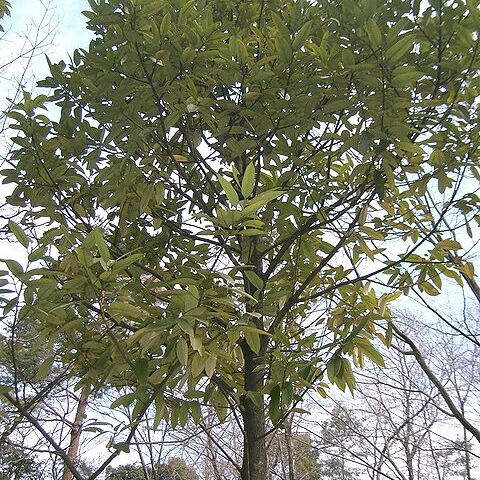Trees evergreen, to 20 m tall, ca. 60 cm d.b.h., glabrous throughout; bark gray-black, smooth. Branches yellow-brown or brown, strong, longitudinally ridged and sulcate, smooth; leaf scars evidently raised, broadly discoid or semicircular. Leaves on first to third year’s branchlets; stipules broadly deltoid, very minute, apically acute; petiole subterete, 1.5-2.5 cm, ca. 3 mm in diam., abaxially rugose, adaxially slightly impressed; leaf blade abaxially greenish, adaxially deep green, shiny, oblong or ovate-oblong, 8-19(-28) × 4.5-7.5(-9) cm, thickly leathery, midvein impressed adaxially, lateral veins 12-17 pairs, obscure abaxially, obvious adaxially, base rounded or broadly cuneate, margin sparsely serrate, teeth black at tips, apex obtuse or shortly acuminate. Inflorescences: cymes, pseudopaniculate or pseudoracemose, axillary on second year’s branchlets; rachis 1-2 cm; bud scales persistent, rounded, imbricate; flowers yellowish green, 4-merous. Male inflorescences: cymes of order 2-4, 3-9-flowered, pseudopaniculate; peduncles ca. 2 mm; bracts ovate or lanceolate, 5-7 × 3-5 mm; pedicels 6-8 mm; bracteoles 1 or 2, deltoid; calyx subcupuliform, ca. 3.5 mm in diam., 4-lobed, lobes orbicular; corolla rotate, ca. 9 mm in diam., petals ovate-oblong, ca. 3.5 × 2.5 mm, basally connate; stamens ca. as long as petals, anthers ovoid-oblong; rudimentary ovary subglobose, apex 4-lobed. Female inflorescences: cymes of order 1 or 2, 1-3-flowered, pseudopaniculate or pseudoracemose; peduncles ca. 2 mm; 1-flowered pedicels 5-8 mm; bracteoles 1 or 2; calyx patelliform, ca. 3 mm in diam.; corolla erect, ca. 5 mm in diam., petals 4, ovate, ca. 3 × 2 mm; staminodes ca. 1/3 as long as petals, sterile anthers ovoid, minute; ovary ovoid, ca. 2 mm in diam., stigma discoid, 4-lobed. Fruit red, globose, ca. 7 mm in diam.; persistent stigma thinly discoid; persistent calyx explanate, discoid; exocarp thick, smooth; pyrenes 4, oblong-ellipsoidal, ca. 5 mm, ca. 2.5 mm in diam., abaxially irregularly rugose and pitted, with distinct longitudinal ridges, endocarp stony. Fl. Apr-May, fr. Sep-Oct.
More
A tree which keeps its leaves throughout the year. It grows 20 m high. The bark is grey and develops long cracks with age. The leaves are oblong. They are 20 cm long by 7.5 cm wide. They are thick and have coarse teeth. They are glossy and dark green above. They are yellow green underneath. They are on stout shoots. The male and female flowers occur in separate plants. The male and female flowers are both small and yellow-green. They are in clusters in the axils of leaves and have a smell. The fruit is orange-red and 8 mm across. These berries occur in clusters.


